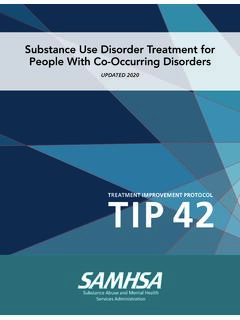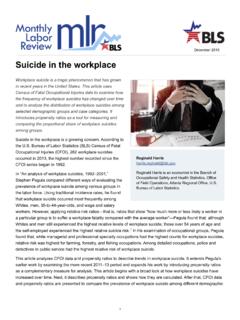Transcription of Preventing Suicide: A Technical Package of Policy ...
1 Preventing Suicide: A Technical Package of Policy , Programs, and PracticesNational Center for Injury Prevention and Control Division of Violence PreventionPreventing Suicide: A Technical Package of Policy , Programs, and PracticesDeveloped by:Deb Stone, ScD, MSW, MPHK ristin Holland, PhD, MPHBrad Bartholow, PhDAlex Crosby, MD, MPHS hane Davis, PhDNatalie Wilkins, PhD2017 Division of Violence PreventionNational Center for Injury Prevention and ControlCenters for Disease Control and PreventionAtlanta, Georgia2 Preventing suicide : A Technical Package of Policy , Programs, and PracticesCenters for Disease Control and PreventionAnne Schuchat, MD (RADM, USPHS), Acting DirectorNational Center for Injury Prevention and ControlDebra E.
2 Houry, MD, MPH, DirectorDivision of Violence PreventionJames A. Mercy, PhD, DirectorSuggested citation: Stone, , Holland, , Bartholow, B., Crosby, , Davis, S., and Wilkins, N. (2017). Preventing suicide : A Technical Package of Policies, Programs, and Practices. Atlanta, GA: National Center for Injury Prevention and Control, Centers for Disease Control and suicide : A Technical Package of Policy , Programs, and Practices 3 ContentsAcknowledgements ..5 External Reviewers ..5 Overview ..7 Strengthen Economic Supports ..15 Strengthen Access and Delivery of suicide Care ..19 Create Protective Environments ..23 Promote Connectedness ..27 Teach Coping and Problem-Solving Skills ..31 Identify and Support People at Risk.
3 35 Lessen Harms and Prevent Future Risk ..41 Sector Involvement ..43 Monitoring and Evaluation ..45 Conclusion ..47 References ..49 Appendix: Summary of Strategies and Approaches to Prevent suicide ..58 Preventing suicide : A Technical Package of Policy , Programs, and Practices 5 AcknowledgementsWe would like to thank the following individuals who contributed in specific ways to the development of this Technical Package . We give special thanks to Linda Dahlberg for her vision, guidance, and support throughout the development of this Package . We thank Division, Center, and CDC leadership for their careful review and helpful feedback on earlier iterations of this document. We thank Alida Knuth for her formatting and design expertise.
4 Last but definitely not least, we extend our thanks and gratitude to all the external reviewers for their helpful feedback, support and encouragement for this ReviewersCasey CastaldiPrevention InstituteCarmen ClellandOffice for State, Tribal, Local and Territorial Support, Centers for Disease Control and PreventionAmalia Corby-EdwardsAmerican Psychological AssociationRachel DavisPrevention InstitutePamela End of HornIndian Health Service HeadquartersCraig FisherAmerican Psychological AssociationKeita FranklinDepartment of DefenseJill M. Harkavy FriedmanAmerican Foundation for suicide PreventionJarrod HindmanColorado Department of Public Health and EnvironmentLinda LangfordEducation Development Center, McKeonSubstance Abuse and Mental Health Services AdministrationDoreen S.
5 MarshallAmerican Foundation for suicide PreventionChristine MoutierAmerican Foundation for suicide PreventionJason H. PadgettEducation Development Center, ReedEducation Development Center, ReidenbergSuicide Awareness Voices for Education (SAVE)Christine SchulerNational Institute for Occupational Safety and Health, Centers for Disease Control and PreventionMorton SilvermanEducation Development Center, StoutEducation Development Center, M. TiesmanNational Institute for Occupational Safety and Health, Centers for Disease Control and PreventionThe experts above are listed with their affiliations at the time this document was suicide : A Technical Package of Policy , Programs, and Practices 7 Overview This Technical Package represents a select group of strategies based on the best available evidence to help communities and states sharpen their focus on prevention activities with the greatest potential to prevent suicide .
6 These strategies include: strengthening economic supports; strengthening access and delivery of suicide care; creating protective environments; promoting connectedness; teaching coping and problem-solving skills; identifying and supporting people at risk; and lessening harms and Preventing future risk. The strategies represented in this Package include those with a focus on Preventing the risk of suicide in the first place as well as approaches to lessen the immediate and long-term harms of suicidal behavior for individuals, families, communities, and society. The strategies in the Technical Package support the goals and objectives of the National Strategy for suicide Prevention1 and the National Action Alliance for suicide Prevention s priority to strengthen community-based Commitment, cooperation, and leadership from numerous sectors, including public health, education, justice, health care, social services, business, labor, and government can bring about the successful implementation of this Package .
7 What is a Technical Package ?A Technical Package is a compilation of a core set of strategies to achieve and sustain substantial reductions in a specific risk factor or Technical packages help communities and states prioritize prevention activities based on the best available evidence. This Technical Package has three components. The first component is the strategy or the preventive direction or actions to achieve the goal of Preventing suicide . The second component is the approach. The approach includes the specific ways to advance the strategy. This can be accomplished through programs, policies, and practices. The evidence for each of the approaches in Preventing suicide or its associated risk factors is included as the third component.
8 This Package is intended as a resource to guide and inform prevention decision-making in communities and states. Preventing suicide is a PrioritySuicide, as defined by the Centers for Disease Control and Prevention (CDC), is part of a broader class of behavior called self-directed violence. Self-directed violence refers to behavior directed at oneself that deliberately results in injury or the potential for Self-directed violence may be suicidal or non-suicidal in nature. For the purposes of this document, we refer only to behavior where suicide is intended: suicide is a death caused by self-directed injurious behavior with any intent to die as a result of the behavior. suicide attempt is defined as a non-fatal self-directed and potentially injurious behavior with any intent to die as a result of the behavior.
9 A suicide attempt may or may not result in injury. suicide is highly prevalent. suicide presents a major challenge to public health in the United States and worldwide. It contributes to premature death, morbidity, lost productivity, and health care ,5 In 2015 (the most recent year of available death data), suicide was responsible for 44,193 deaths in the , which is approximately one suicide every 12 In 2015, suicide ranked as the 10th leading cause of death and has been among the top 12 leading causes of death since 1975 in the Overall suicide rates increased 28% from 2000 to suicide is a problem throughout the life span; it is the third leading cause of death for youth 10 14 years of age, the second leading cause of death among people 15 24 and 25 34 years of age.
10 The fourth leading cause among people 35 to 44 years of age, the fifth leading cause among people ages 45 54 and eighth leading cause among people 55 64 years of 8 Preventing suicide : A Technical Package of Policy , Programs, and PracticesSuicide rates vary by race/ethnicity, age, and other population characteristics, with the highest rates across the life span occurring among non-Hispanic American Indian/Alaska Native (AI/AN) and non-Hispanic White population groups. In 2015, the rates for these groups were and per 100,000 population, Other population groups disproportionately impacted by suicide include middle-aged adults (whose rates increased 35% from 2000 to 2015, with steep increases seen among both males (29%) and females (53%) aged 35 64 years6; Veterans and other military personnel (whose suicide rate nearly doubled from 2003 to 2008, surpassing the rate of suicide among civilians for the first time in decades)8,9.)
















